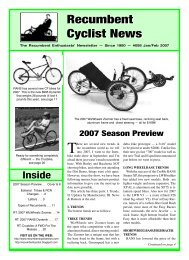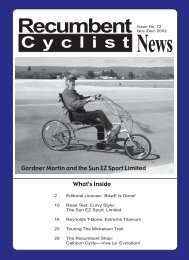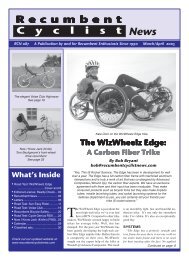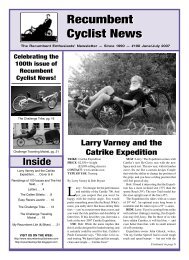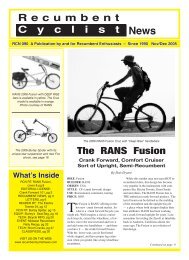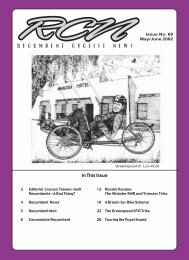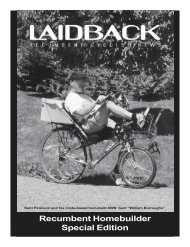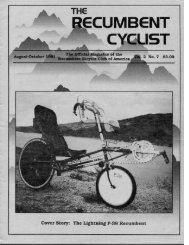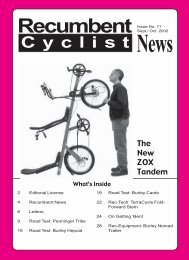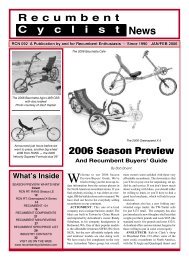C y c l i s t Recumbent - Steve Briggs
C y c l i s t Recumbent - Steve Briggs
C y c l i s t Recumbent - Steve Briggs
You also want an ePaper? Increase the reach of your titles
YUMPU automatically turns print PDFs into web optimized ePapers that Google loves.
is a truly remarkable machine. The bicycle adds only about 10% to a<br />
rider’s weight. Yet it provides a mechanical advantage that lets you<br />
range over distances many times greater than you could do on foot, at<br />
speeds roughly two to three times faster than the fastest speeds humans<br />
typically muster. The modern bike is such a highly optimized<br />
machine that nearly every source of friction and loss has been designed<br />
out of it. Off hand, you might think there’s really not much left to<br />
improve, but clearly that’s not true. There are still big losses in the<br />
drivetrain, in tire friction, and — of course — in aerodynamics. These<br />
chinks in the armor leave lots of room for clever designers to find practical<br />
ways to squeeze greater performance out of a bike.<br />
The chink in the armor Rotor strikes at is the mismatch between the<br />
body and the cranks: the conversion of the natural piston-like up-anddown<br />
motion of the legs to the round-and-round motion required by<br />
the bike. Engine designers solved a similar problem ages ago by figuring<br />
out how to convert the linear motion of the pistons to the circular<br />
motion of the drive shaft, using a crankshaft, cams, and other linkages.<br />
But up to now cyclists have had to do this conversion themselves, using<br />
the small muscles in their ankles, knees, and other joints to try to<br />
pedal smoothly in a circular motion; a process that is not only inefficient,<br />
but stressful on the body. The Rotor System solves this linkage<br />
problem in an ingenious way, and the result is a system that improves<br />
the efficiency of your pedaling while reducing the stress on your joints.<br />
How They Work<br />
The Rotors improve the efficiency of cycling in two ways. First,<br />
they effectively eliminate the “dead spot” in the cycle (the point in the<br />
cycle where no matter how hard you push down against the pedals, the<br />
cranks cannot turn). Second, they help by “gearing down” as you pedal<br />
through the dead spot, giving you a mechanical advantage in the part<br />
of the stroke in which you need it most.<br />
With traditional cranks, both arms of the cranks are always fixed in<br />
a line. So, when one leg gets stuck in the dead spot (at 12 ‘o clock on<br />
an upright), the other one is stuck there too (at 6 ‘o clock). But the<br />
Rotors do an ingenious thing. While the two cranks are in line at the<br />
most powerful part of the stroke, they go slightly out of line once<br />
every cycle as your foot approaches the dead spot. And with the cranks<br />
no longer in a line, even when one foot is locked in the “dead” position,<br />
the other foot is still able to push. The net result is that one foot<br />
helps push the other through the dead spot, as if there’s a “power assist”<br />
to keep you from getting stuck. This means you’re whipping<br />
through the dead spot at a much faster rate — it’s as if you are going<br />
into a lower gear as your foot nears the dead spot.<br />
The feeling is uncanny, and you have to try it to really get a sense of<br />
the difference. The long and the short of it is that between the “power<br />
assist” from the other leg, and the fact that you spend less time in the<br />
dead spot, your cadence goes up, and you just don’t waste as much<br />
muscle pushing against a dead crank. And so your power soars!<br />
Reducing Knee Pain<br />
An unexpected and welcome benefit of the Rotors is that while they<br />
increase your power they also reduce the stresses on your joints. You<br />
can easily see how Rotors might help reduce knee pain by doing a little<br />
test for yourself: Try rocking your cranks back and forth a few degrees<br />
around the dead spot — applying a bit of pressure as you do (don’t<br />
overdo!) — and you’ll feel some very unpleasant sensations in the knee<br />
that is bent. The more you press down into the dead spot the more<br />
you’ll feel your patella lift up, straining and damaging the small muscles<br />
and tendons in the knee.<br />
The Rotors prevent this damage by whipping your knees through<br />
the dead spot while at same time reducing the forces you need to get<br />
out of this potentially painful position. When you realize that your knees<br />
go through the dead spot roughly 10,000 times every hour you ride,<br />
you can see how the Rotors might save your knees. So in the end, your<br />
joints feel better and you get more power, too!<br />
Simple Design — Built around a cam, there are few moving<br />
parts to wear. Routine maintenance only calls for a drop of oil<br />
here and there, whenever the chain is lubed. (Adapted from<br />
drawing courtesy Rotor Systems.)<br />
First Ride Out<br />
For my first ride with the Rotors, I went out for 25 miles on an easy<br />
route that included some gentle grades. It took me only about 15 minutes<br />
to get used to the different feel, but at first I didn’t really notice<br />
much change in performance. After riding some more I figured out<br />
that my old pedaling habits, designed and practiced to help me get<br />
through the dead spot, were all wrong for the Rotors.<br />
Normally when I ride, I’m silently chanting a mantra “steady<br />
circles… steady circles” to help me pull my legs through the dead spot<br />
(a motion some people describe as wiping your feet on a mat). Well,<br />
ten miles out I figured out that this was exactly the wrong thing to do<br />
when riding with Rotors. The Rotors’ “power assist” pulls your legs<br />
through the dead spot for you. It’s automatic. So you can forget about<br />
wiping your feet on the mat, forget about your mantras, forget about<br />
the dead spot, and just let the Rotors do all the heavy lifting. All you<br />
have to do is to mash down as hard as you can using the biggest muscles<br />
you have in your legs. Once I figured this out, my legs started firing up<br />
and down like they were pistons in a car engine. My cadence went up<br />
and I felt my power rocket through the roof! This was cool!<br />
The rest of my maiden ride was spectacular. At times I was cruising<br />
so fast and effortlessly I actually had to double check whether I had<br />
wind at my back! (I didn’t.) I have been riding this route for years and<br />
just couldn’t believe the speeds I was seeing overall. I was hitting<br />
personal bests for this route on my first time out.<br />
On the small hill I normally climb huffing and puffing at 16 mph, I<br />
was now over 20 mph. And I wasn’t even sucking wind the way I normally<br />
would at this point. By the time I neared the end of my first ride<br />
I felt like Superman. If any roadies had come along and tried to pass<br />
me at that moment I would have pulverized them.<br />
The action of the cranks is smooth, and there’s no discernible play in<br />
the cranks. In fact, when you’re pedaling in true Rotor form, you feel<br />
like you’re putting power to the cranks almost continuously. The motion<br />
feels smooth and tight, like the feeling I used to experience riding<br />
a fixed-gear track bike, a feeling I never thought I’d experience riding<br />
a ‘bent.<br />
How Much Speed Will I Gain?<br />
Rotor cranks are relatively new, and are only just now catching hold<br />
with the fast racing crowd that makes a science of performance measurement.<br />
But reports from time trials and other competitions are now<br />
beginning to come in, and word on the street is that riders are seeing<br />
improvements in their speeds amounting to about two minutes over an<br />
Sept./Oct. 2004 25 25<br />
25



